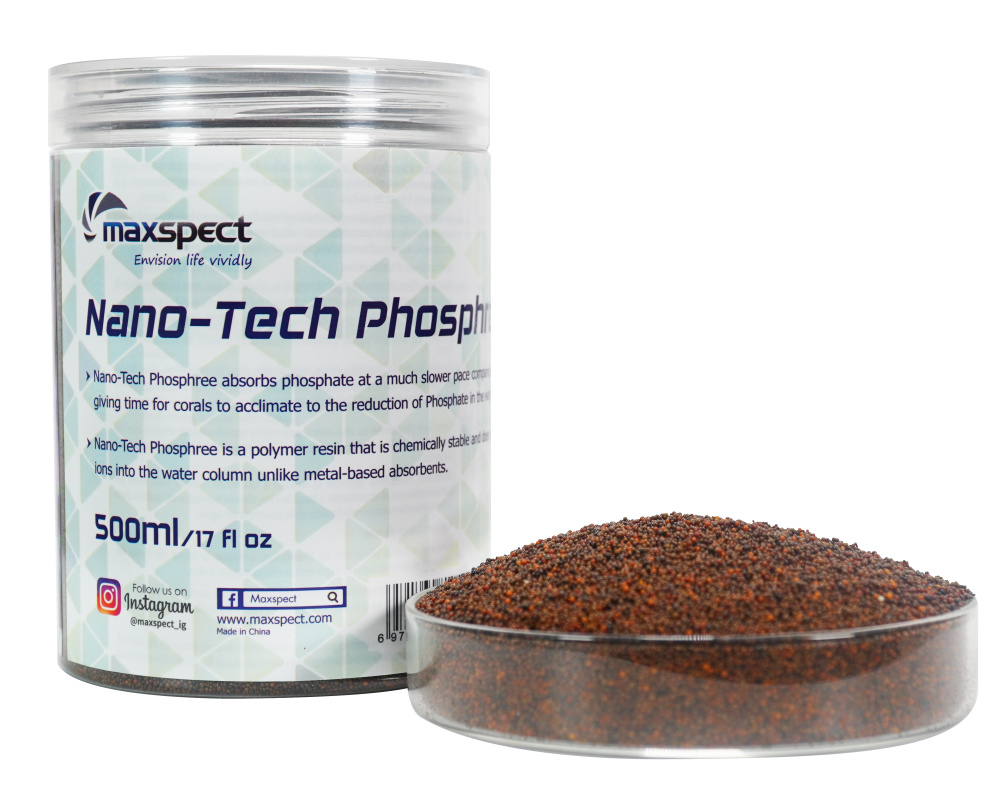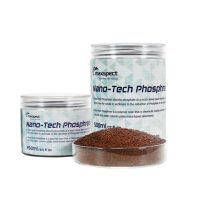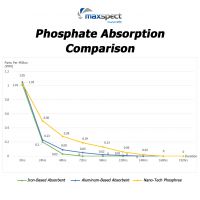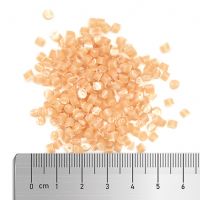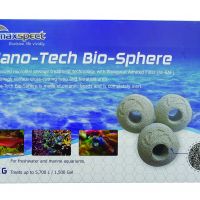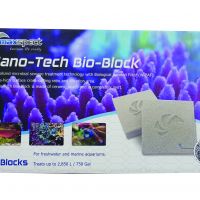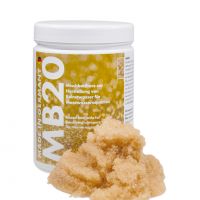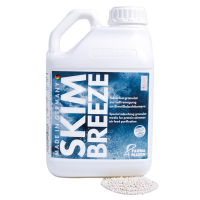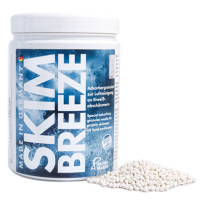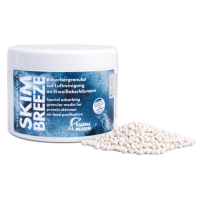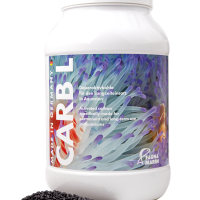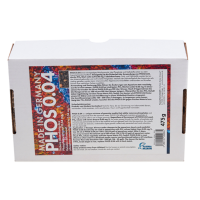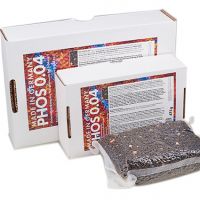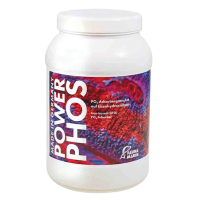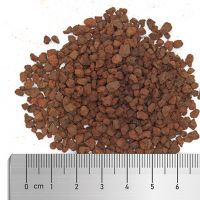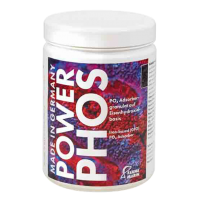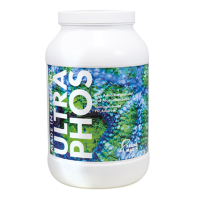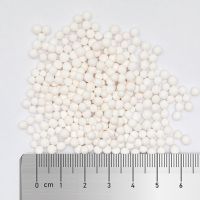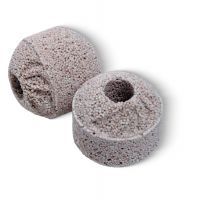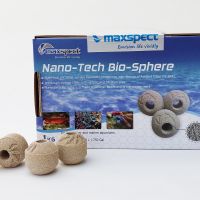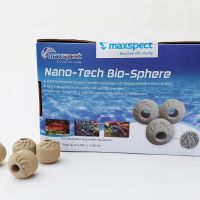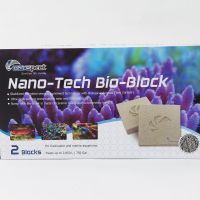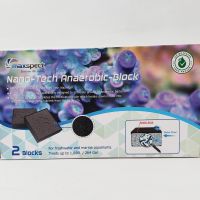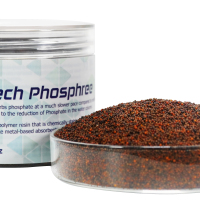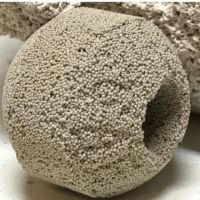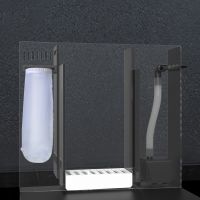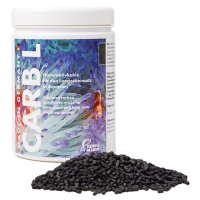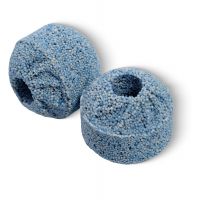Nano Tech PhosPhree 500ml

Nano-Tech Phosphree is a polymer resin that is chemically stable and does not leak any metal ions into the water column unlike metal-based absorbents.
“Phosphree is specially designed to absorb phosphate at a much slower pace compared to other metal-based absorbents, giving time for corals to acclimate to the reduction of phosphate in the water column.”
Rapid reduction of phosphate in the water column could stress out corals, and in the worst-case scenario, may lead to Rapid Tissue Necrosis or RTN.
Comes in 2 sizes:
250 ml (8.5 fl oz) will remove 3 ppm of phosphate from a 1000 litres (264 gallons) marine/reef aquarium.
500 ml (17 fl oz) will remove 3 ppm of phosphate from a 2000 litres (528 gallons) marine/reef aquarium.
To establish a controlled environment for Phosphate Absorption Rate Test, we’ve prepared three tanks with 100L of seawater, all containing 1.0ppm (±0.03) of phosphate.
Tank A: 100L of seawater with 60ml of Iron-Based Absorbent
Tank B: 100L of seawater with 60ml of Aluminium-Based Absorbent
Tank C: 100L of seawater with 60ml of Nano-Tech Phosphree
Photometer used to test for phosphate: Hanna HI97713 Phosphate Low-Range Portable Photometer
Step 1: Preparation of 100L of seawater with 1.0ppm phosphate content.
The tests cannot be conducted in an actual aquarium with livestock because phosphate is constantly generated by the animals. Hence, we prepare the testing environment using Tricalcium phosphate.
We add 326.6mg of Tricalcium phosphate into 100L of seawater to bring the phosphate level to 1.0ppm (±0.03)
Step 2: Testing procedures
- We place 60ml of the absorbents into the testing tanks, with medium water flow provided by a Gyre pump.
- Three (3) water samples from each testing tank were collected every 24 hours for 8 days, we take the average reading of the three water samples.
The Results can be seen in the graph above.
Directions of use:
For quick removal of phosphate, you can use a media rector the tumbling of the material will take the phosphate from the water at a much faster rate than using it in a mesh bag. However, be aware that removing phosphate quickly from the water column can cause stress to corals perhaps contributing to RTN (Rapid Tissue Necrosis) within the aquarium so take care when using this method.
The alternative method is to place PhosPhree in a media bag this is how we performed our testing and found it to remove phosphate at a slower rate than iron and aluminium based removers using the same method.
Suggested starting dosage rates and method
1/ We would recommend you do a P04 (phosphate) test on your aquarium to establish the amount of phosphate you need to remove.
2/ Start with 10ml of PhosPhree per 100L of aquarium water.
3/ measure the amount of P04 again 3 days later if the amount has decreased you are on the right track if it has remained the same or increased you will need to up volume of PhosPhree and repeat this process in another 3 days.
4/ Continue to measure the amount of P04 in the aquarium with testing until it reaches a target amount example 0.03ppm
5/ Continue to monitor P04 in the aquarium if it increases it may mean its time to replace the media.
We are fully aware that in some cases an aquarium can have super high levels of phosphate maybe 10ppm in these cases the client may need to use a higher volume of media to bring the level down to a manageable amount then maintain it.
PhosPhree will not affect other components in the aquarium we have heard some media can play with Kh levels but this is not the case with PhosPhree it only works on phosphate.
Nano-Tech Phosphree is a polymer resin that is chemically stable and does not leak any metal ions into the water column unlike metal-based absorbents.
“Phosphree is specially designed to absorb phosphate at a much slower pace compared to other metal-based absorbents, giving time for corals to acclimate to the reduction of phosphate in the water column.”
Rapid reduction of phosphate in the water column could stress out corals, and in the worst-case scenario, may lead to Rapid Tissue Necrosis or RTN.
Comes in 2 sizes:
250 ml (8.5 fl oz) will remove 3 ppm of phosphate from a 1000 litres (264 gallons) marine/reef aquarium.
500 ml (17 fl oz) will remove 3 ppm of phosphate from a 2000 litres (528 gallons) marine/reef aquarium.
To establish a controlled environment for Phosphate Absorption Rate Test, we’ve prepared three tanks with 100L of seawater, all containing 1.0ppm (±0.03) of phosphate.
Tank A: 100L of seawater with 60ml of Iron-Based Absorbent
Tank B: 100L of seawater with 60ml of Aluminium-Based Absorbent
Tank C: 100L of seawater with 60ml of Nano-Tech Phosphree
Photometer used to test for phosphate: Hanna HI97713 Phosphate Low-Range Portable Photometer
Step 1: Preparation of 100L of seawater with 1.0ppm phosphate content.
The tests cannot be conducted in an actual aquarium with livestock because phosphate is constantly generated by the animals. Hence, we prepare the testing environment using Tricalcium phosphate.
We add 326.6mg of Tricalcium phosphate into 100L of seawater to bring the phosphate level to 1.0ppm (±0.03)
Step 2: Testing procedures
- We place 60ml of the absorbents into the testing tanks, with medium water flow provided by a Gyre pump.
- Three (3) water samples from each testing tank were collected every 24 hours for 8 days, we take the average reading of the three water samples.
The Results can be seen in the graph above.
Directions of use:
For quick removal of phosphate, you can use a media rector the tumbling of the material will take the phosphate from the water at a much faster rate than using it in a mesh bag. However, be aware that removing phosphate quickly from the water column can cause stress to corals perhaps contributing to RTN (Rapid Tissue Necrosis) within the aquarium so take care when using this method.
The alternative method is to place PhosPhree in a media bag this is how we performed our testing and found it to remove phosphate at a slower rate than iron and aluminium based removers using the same method.
Suggested starting dosage rates and method
1/ We would recommend you do a P04 (phosphate) test on your aquarium to establish the amount of phosphate you need to remove.
2/ Start with 10ml of PhosPhree per 100L of aquarium water.
3/ measure the amount of P04 again 3 days later if the amount has decreased you are on the right track if it has remained the same or increased you will need to up volume of PhosPhree and repeat this process in another 3 days.
4/ Continue to measure the amount of P04 in the aquarium with testing until it reaches a target amount example 0.03ppm
5/ Continue to monitor P04 in the aquarium if it increases it may mean its time to replace the media.
We are fully aware that in some cases an aquarium can have super high levels of phosphate maybe 10ppm in these cases the client may need to use a higher volume of media to bring the level down to a manageable amount then maintain it.
PhosPhree will not affect other components in the aquarium we have heard some media can play with Kh levels but this is not the case with PhosPhree it only works on phosphate.

